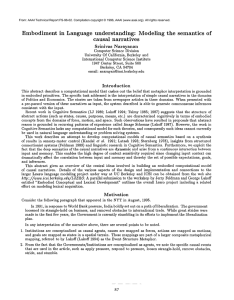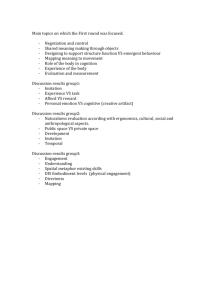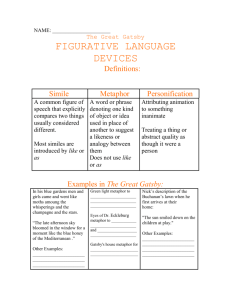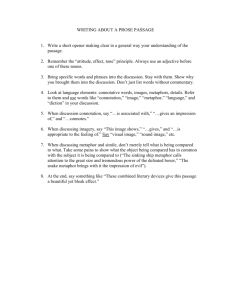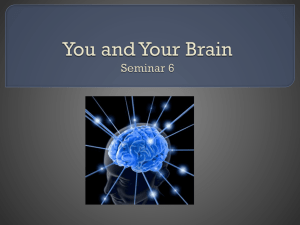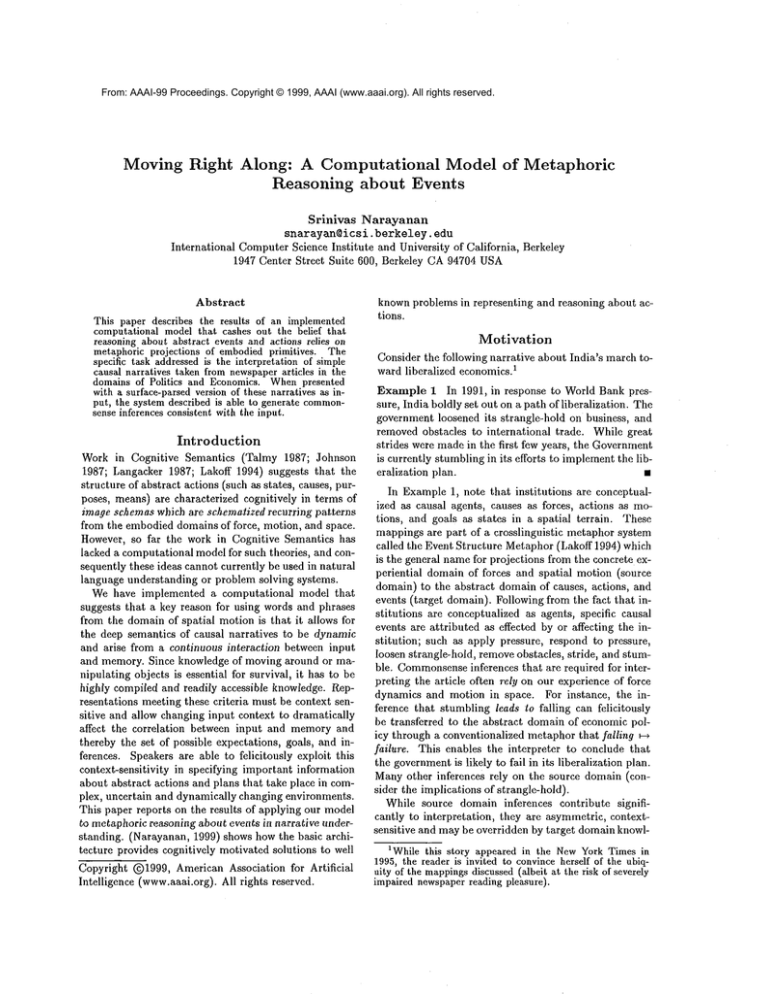
From: AAAI-99 Proceedings. Copyright © 1999, AAAI (www.aaai.org). All rights reserved.
Moving Right Along: A Computational Model of Metaphoric
Reasoning about Events
Srinivas
Narayanan
snar ayan@ics i. berkeley,
edu
International ComputerScience Institute and University of California, Berkeley
1947 Center Street Suite 600, Berkeley CA 94704 USA
Abstract
This paper describes the results of an implemented
computational model that cashes out the belief that
reasoning about abstract events and actions relies on
metaphoric projections of embodied primitives. The
specific task addressed is the interpretation of simple
causal narratives taken from newspaperarticles in the
domains of Politics and Economics. Whenpresented
with a surface-parsed version of these narratives as input, the system described is able to generate commonsense inferences consistent with the input.
Introduction
Work in Cognitive Semantics (Talmy 1987; Johnson
1987; Langacker 1987; Lakoff 1994) suggests that the
structure of abstract actions (such as states, causes, purposes, means) are characterized cognitively in terms of
image schemas which are schemalized recurring patterns
from the embodied domains of force, motion, and space.
However, so far the work in Cognitive Semantics has
lacked a computational model for such theories, and consequently these ideas cannot currently be used in natural
language understanding or problem solving systems.
We have implemented a computational model that
suggests that a key reason for using words and phrases
from the domain of spatial motion is that it allows for
the deep semantics of causal narratives to be dynamic
and arise from a continuous interaction between input
and memory. Since knowledge of moving around or manipulating objects is essential for survival, it has to be
highly compiled and readily accessible knowledge. Representations meeting these criteria must be context sensitive and allow changing input context to dramatically
affect the correlation between input and memoryand
thereby the set of possible expectations, goals, and inferences. Speakers are able to felicitously exploit this
context-sensitivity in specifying important information
about abstract actions and plans that take place in complex, uncertain and dynamically changing environments.
This paper reports on the results of applying our model
to metaphoric reasoning about events in narrative understanding. (Narayanan, 1999) shows how the basic architecture provides cognitively motivated solutions to well
Copyright @1999, American Association for Artificial
Intelligence (www.aaai.org). All rights reserved.
known problems in representing and reasoning about actions.
Motivation
Consider the following narrative about India’s march toward liberalized economics)
Example I In 1991, in response to World Bank pressure, India boldly set out on a path of liberalization. The
government loosened its strangle-hold on business, and
removed obstacles to international
trade. While great
strides were made in the first few years, the Government
is currently stumbling in its efforts to implementthe liberalization plan.
¯
In Example 1, note that institutions are conceptualized as causal agents, causes as forces, actions as motions, and goals as states in a spatial terrain. These
mappings are part of a crossliuguistic
metaphor system
called the Event Structure Metaphor (Lakoff 1994) which
is the general name for projections from the concrete experiential domain of forces and spatial motion (source
domain) to the abstract domain of causes, actions, and
events (target domain). Following from the fact that institutions are conceptualized as agents, specific causal
events are attributed as effected by or affecting the institution; such as apply pressure, respond to pressure,
loosen strangle-hold, removeobstacles, stride, and stumble. Comrnonsenseinferences that are required for interpreting the article often rely on our experience of force
dynamics and motion in space. For instance, the inference that stumbling leads to falling can felicitously
be transferred to the abstract domain of economic policy through a conventionalized metaphor that falling H
failure. This enables the interpreter to conclude that
the governmentis likely to fail in its liberalization plan.
Manyother inferences rely on the source domain (consider the implications of strangle-hold).
While source domain inferences contribute significantly to interpretation, they are asymmetric, contextsensitive and may be overridden by target domain knowl1While this story appeared in the NewYork Times in
1995, the reader is invited to convince herself of the ubiquity of the mappingsdiscussed (albeit at the risk of severely
impaired newspaperreading pleasure).
Metaphoric
ProJection t
I00000000000
0 0000
IX
00~\
/
Figure 1: Metaphors capture systematic correlations
tween features of different domains.
be-
edge. For instance, stumble ==~fall (and the corresponding metaphoric inference of plan failure) is only a default
causal inference that is made in the absence of information to the contrary. Such an inference may be nonmonotonically disabled in the face of target domain evidence that the liberalization plan is succeeding.
In summary, we note that a large proportion of commonplacedescriptions of abstract events seem to project
embodied, familiar, concepts onto more abstract domains such as economics and politics. This allows nonexperts to comprehend and reason about such abstract
policies and actions in terms of more familiar and universal embodied concepts. The fact that the metaphoric
inferences are context-sensitive, immediate, and defeasible set up fairly strong representational requirements for
a metaphor interpretation system.
Model
The specific hypothesis pursued here is that the meaning of motion and manipulation terms is grounded in
patterns generated by our sensory and motor systems as
we interact in the world. Systematic metaphors project
these features onto abstract domains such as Economics
enabling linguistic devices to use motion terms to describe abstract actions and processes. Figure 1 shows
the basic computational architecture of the implemented
system. As shown in the figure the system has three
main components, namely the source domain, the target domain and the metaphor maps. These components are discussed below.
The source
domain
Wehypothesize that the causal theory of the familiar
and essential domain of embodied motion is encoded as
highly accessible compiled knowledge used both for action monitoring and failure recovery and for fast, parallel, real-time reflexive inference in interpretation. We
refer to this fine-grained, executing model of events as
x-schemas. The model is based on results in sensorymotor control (Pearson 1993) and linguistic research
in Cognitive Semantics. Formally, the computational
model is an extension to Stochastic Petri Nets (Murata
1989). A Petri net is a bipartite graph containing places
(drawn as circles) and transitions (rectangles). Places
hold tokens and represent predicates about the world
state or internal state. Transitions are the active component. Whenall of the places pointing into a transition
contain an adequate number of tokens (usually 1) the
transition is enabled and may fire, removing its input
tokens and depositing a new set of tokens in its output
places. The most relevant features of Petri nets for our
purposes are their ability to model events and states in
a distributed system and cleanly capture sequentiality,
concurrency and event-based asynchronous control. Our
extensions to the basic Petri net formalism include typed
arcs, hierarchical control, durative transitions, parameterization, typed (individual) tokens and stochastieity.
For this paper, the crucial fact about our representation
is that it is active with a well specified real-time execution semantics that can be used for acting and reacting
in dynamic environments or for context sensitive simulative inference in language understanding.
The central idea behind our model is that the reader
interpreting a phrase that corresponds to a motion term
is in fact performing a mental simulation of the entailed
event in the current context. The basic idea is simple.
We assume that people can execute x-schemas with respect to structures that are not linked to the body, the
here and the now. In this case, x-schema actions are
not carried out directly, but instead trigger simulations
of what they would do in the imagined situation.
We
model the physical world as other x-schemas that have
i/o links to the x-schema representing the planned action.
In our implementation, source domain structure is encoded as connected x-schemas. Our model of the source
domain is a dynamic system based on inter-x-schema
activation, inhibition and interruption. In the simulation framework, whenever an executing x-schema makes
a control transition, it potentially modifies state, leading
to asynchronous and parallel triggering or inhibition of
other x-schemas. The notion of state as a graph marking
is inherently distributed over the network, so the working memoryof an x-schema-based inference system is
distributed over the entire set of x-schemas and source
domain f-structs (see Figure 1). Of course, this is intended to model the massively parallel computation of
the brain.
Figure 2 depicts a simplified x-schema model of walk-
WALK
~
re~dy sterl ~golng finish done (’~[
:
FALL
11ACTOR,
P(AcroR,0) P(ACTOR~
)(
uso =.6
Policy
Do c_
u,~,~o,e
’C.~ STABmiZE
GET~
P(AC’i’OR,
2 [ ACrOR,
~
hange(~
(,_
(")
T= I
2"-- 2
Policy Status
Oulcome/
l_-O<.t
so£dm°,.P-,,,.°,
°°l(
use(energy)
Dog. Complete
Figure 2: Source Domainis a x-schema simulation environment used for inference.
ing and reacting to obstacles. For instance, during a
walk (specified by a token in the ongoing phase of the
WALK
x-schema) encountering an unanticipated
bump,
you become unstable. 2 This may lead to a FALLunless
you are able to simultaneously expend energy and STABILIZE, in which case you may resume the interrupted
walk. If you are unable to STABILIZE, and thus FALL,
you will be down and hurt. In order to start walking
again you will have to GETUP and be standing and in
control again.
An important and novel aspect of our source domain
representation is that the same system is able to respond to either direct sensory-motor input or other
ways of setting the agent state (such as linguistic devices). This allows for the same mechanism to perform simulative reasoning and generate inferences from
linguistic input as well as be used for high-level control and reactive planning. There is some biological
evidence to support this view (IZizzolatti et ai 1996;
Tanji & Shima 1994) that planning, recognition and
imagination share a commonrepresentational substrate.
Target
domain
representation
The structure of the abstract domain (the domain of international economic policies) encodes knowledge about
Economic Policies. We require that our representation be capable of a) representing background knowledge (such as US is a market economy), b) modeling
inherent target domain structure and constraints (highgrowth may result in higher inflation), and c) be capable of computing the impact of new observations which
may from direct input ("US economy is experiencing
high-growth"), or from metaphoric (or other) inferences
("Economy stumbling"). Furthermore, these different
sources of evidence have different degrees of believability, and the representation must provide a framework
for their combination. For all these reasons, we chose to
2In fact, the simulation is of finer granularity in that it
is during an ongoing STEP(subschema of WALK), that the
interruption occurs. This is not shownto simplify exposition.
2"-- 0
Figure 3: Target Domainis a temporally extended Belief
net.
represent the target domain as a Belief network (Jensen
1996). Belief networks are the dominant methodology
for reasoning with uncertain knowledge sources. They
provide a principled and coherent semantics based on
probability theory, which allows us to study the joint
impact of metaphoric inference, background knowledge
and inherent target structure using well understood, offthe-shelf algorithms.
Our model of the target domain consists of multiple copies (up to 4 ) of a temporally extended Belief
net (Dean ~z Welhnan1991), representing different time
slices. The structure of the target domain for three
temporal slices of the Belief network is shown in Figure 3. Within a single temporal slice, the nodes of
the network correspond to economic variables which
can take on different values.For instance, in Figure 1,
we have a node corresponding the the economic actor which can be instantiated
to be the US government, IMF, Indian Government, etc. Links within a
single time slice model the probabilistic dependence between variables. For instance, there is a link between
the actor variable and the policy variable, which models the fact that if we knew the actor in question (US
Government) we would have a good idea of the policy (free-market economy). The strength of this belief is quantified as the conditional probability table
P(Policy[Actor). Links between nodes at different time
slices encode the conditional probability of a variable’s
value at time t, given its value at t - 1. For instance,
the link P((Actor, 1)l(Actor, 0)) (ref. to the top of Figure 3) results in the conditional probability table (eFT)
that corresponds to the probability of a specific actor
being instantiated
at time t = 1, given the value of
the actor at time t = 0. These values are default values and are often overridden by specific assertions as we
will soon see in detail in the next section. From such
local conditional probability tables, BELIEFPROPAGA-
domain as degree of completion of a plan.
I/O
looooooo
X.SCHEMA
REPRESENTATION
ANDINFERENCE
Figure 4: Metaphor maps project source f-struct values
as target domain evidence on one or more slice of the
target domainBelief net.
TIONalgorithms (Jensen 1996) compute the global posterior probabilities for the entire network propagating
influences backward and forward in time.
Metaphor
maps
In our model, metaphor maps connect the x-schema
based representations to the belief network representing
knowledge about international
economics. Such maps
project specific results of x-schema executions by projecting specific source domainf-struct values to the target domain by asserting new evidence at one or more
time slices of the temporally extended Belief net. Figure 4 shows the projection of "stumbling" onto the target domain. We will return to this example in the next
section.
Our model currently includes three different types of
embodied maps. One type of map corresponds to ontological maps (Lakoff 1994) which map entities and
objects between embodied and abstract domains. Such
maps are called OMAPS.One central function of OMAPS
is to map the fillers of various case-roles of an event
phrase across domains. A second type of map projects
events, actions, and processes from embodied to abstract
domains. In keeping with our representation, we will call
such maps Schema maps or SMAPS.An important function of SMAP projection is to invariantly mapthe aspect
of the embodied domain event onto the target domain.
A third type of map projects x-schema parameters from
source to target domains. Such maps are called x-schema
parameter maps (PMAPS). Examples include maps that
project velocities onto the abstract domain as the rate
of progress made; or distance traveled onto the abstract
behavior
In this model, a story represents the specification of a
partial trajectory over epistemic states. This is done by
clamping someof the Belief network nodes to specific values. The remaining features are estimated using known
target domain inter-feature correlations as well as from
metaphoric projections from the highly compiled embodied domain knowledge (x-schemas). Metaphoric projections of x-schema executions may clamp target features
to specific values (by creating newevidence on the target
domain belief net shown in Figure 3).
Table 1 and Table 2 illustrate the I/0 behavior of the
implemented system interpreting
the newspaper headline Liberalization plan stumbling. The input to the system is a set of feature-value pairs (called "F-structs")
resulting from a partial parse.
Table 1: Input is a set of F-structs
Feature
Event
DomMn
Ec. Policy
Aspect
Value
stumble
Ec. Policy
Liberalization
Present-Prog
Comprehendinga story corresponds to finding the set
of trajectories that satisfy the constraints of the story
and are consistent with the domain knowledge. This
mayinvolve filling in missing values or creating new evidence on the Belief network. Features with highly selective posterior distributions are likely to be present in
the recall of the story.
Table 2: Output is a new set of F-structs
Feature
Event
Domain
Ec. Policy
Aspect
Context
Status
Outcome
Goal
Value
stumble
Ec. Policy
Liberalization
Present-Prog
ongoing-plan A difficulty
suspended (.8)
fail (.7)
free-trade A deregulation
The result of processing the input in Table 1 is a set of
new bindings asserted in the target domain resulting in
an updated posterior for other variables. This is the situation shown in Table 2. Bold entries correspond to cases
where the change from the prior is a result of metaphoric
inference. Of particular interest is the context setting
inference which projects the embodied knowledge that
stumbling occurs as a result of an obstacle while executing a step (causing an interruption to forward motion)
to the target as plan difficulty (causing a temporary suspension).
Of course, many possible x-schema bindings, especially those that don’t activate any conventional
metaphor are invalid and thus have no impact on the
agent’s epistemic state (for example the source inference
stumble ~ losing balance). Thus the inferences that
are actually made are context-sensitive
and depend on
the target domain and the associated set of metaphoric
maps.
The resultant target network state shown in Table 2
is now a prior for processing the next input at stage
t -- 2. Background knowledge is encoded as the network
state at t = 0. Potentially target inferences can go
forward and backward in time in the estimation of the
most probable explanation of the input story.
Results
Currently our embodied domain theory has about 100
linked x-schemas, while the abstract domain theory is
relatively sparse with a belief net of about 20 multivalued variables with at most 4 temporal stages. We
have also encoded about 50 metaphor maps from the
domains of health and spatial motion. These were developed using a database of 30 2 - 3 phrase fragments
from newspaper stories all of which have been successfully interpreted by the program. All the examples in
this section have been taken from our database.
X-schema
parameters
Distances, speeds, force-values, sizes and energy-levels
are obviously important perceptual and motor control
parameters, but with PMAPprojections,
they become
important descriptive features of events in abstract domains including impacting early parsing decisions of inferring semantic role assignments.
In our examples, we were able to use PMAPsto map
size parameters like giant steps, large step, small steps,
great leap forward (including the Chinese EconomicP~eform); speed parameters in expressions like slow progress,
slowed down,sprint, jog, and long, painful slide into recession; rate and mannerparameters in crawl, leap, trod,
plod, slog, lurch and slither; distance related parameters
in expressions like almost there, long way to go, halfway
there, and a little further. Force magnitudes and durations were also routinely projected as in grip,tear down
hold back.
Aspectual
inferences
(Narayanan, 1997) previously described an x-schema
based model of of aspect (the internal temporal structure of events) which is able to detect and model subtle
interactions between grammatical devices (such as morphological modifiers like be + V-tug (progressive aspect)
versus has V-ed (perfect aspect)) and the inherent
pect of events (such as the inherent iterativity of tap or
rub, or the punctuality of cough or hit). In examining
our metaphor database, we found aspectual distinctions
to be invariantly projected across domains.
In addition to the stumbling example described earlier,
our system could interpret cases which used the perfect
aspect to signal focus on the consequent state of the
described event as in have robbed, has been lurching forward, has sidestepped. Wecould also nicely model several
other high frequency aspectual expressions such as start
to pullout, on the verge of, still trying to climb out of recession and metaphoric expressions of aspect such as set
out, remain stuck in recession, on-track, and the interesting phrase back-on-track. In summary, almost every
event description had an aspectnal component, and so we
believe attention to the details of the semantics of verbal
aspect is essential even to interpret the simplest of event
phrases and distinctions. Webelieve our model is unique
in integrating the semantics of aspect with metaphoric
interpretation.
Goals~
resources
It is well known that narratives are generally about
goals (their accomplishment, abandonment, etc.) and resources (their presence, absence, levels, etc.) (Wilensky
1983; Schank & Abelson 1977; Carbonell 1982). However, in our experiments, we found that embodied motion and manipulation terms may in fact be compactly
coding for these features as well. Narratives are able
to exploit the dynamic and context-sensitive nature of
x-schema representations to assert changing goals and
resources. Amount of energy usually maps to resource
levels as in slog, anemic, sluggish or bruised and bloodied, or stagger to their feet. Similarly tearing barriers or
lightening burdens are able to assert conditions where an
impediment to goal achievement has now been removed.
Compare this to the expression go around or sidestep
where the strategy is one of avoidance rather than direct confrontation. Similarly slippery slopes, slipperiest stones, slide into recessions, get projected through
SMAPS
as the possible thwarting of goals due to unanticipated circumstances. Falling is interesting in this regard
in that in all the cases where a country was described as
falling into recession, we never saw a case in which the
country’s administration was directly blamed as being
able to control the downturn, a fact directly projectable
from the fact that falling is not controllable (an obvious
and easy inference about fall). No such inference is intended or available from processing Germanyhas walked
into recession.
Multiple
source
domains
Multiple source domains pose no problem for the system, as long as they are interpretable and coherent in
the target. For instance, in the input Stocks were down,
bul recovered, S~ocks down activates the Less IS Down
metaphor, while the second input recover activates the
More IS Healthy metaphor leading to the inference of
increasing stocks.
Novel
expressions
As (Lakoff 1994; Gibbs 1994) and other researchers point
out, a variety of novel expressions in ordinary discourse
as well as in poetry makeuse of highly conventionalized
mappings such as the ones described here. In fact, the
implemented system is able to interpret novel expressions which it has never seen in the context of abstract
actions and plans. For example, the concrete domain
meaning of crossroads (multiple possible paths) and the
event structure metaphor maps allow the system to interpret the previously unseen expression in the domain
of abstract actions as a choice point for the planner with
multiple possible plan continuations.
Other examples of novel expressions (in our database)
correctly interpreted by our program include roadblocks,
anemic recovery, lurching forward, long, painful slide,
treading on toes, and the beautiful stumble over rocky
relationship.
Agent attitudes
and affects
Wefound agent attitudes to be essential ways of encoding anticipatory conditions, motivation and determination of agents involved. We have implemented some of
this in the prototype system. For instance bold (Example 1) encodes determination in the face of anticipated
obstacles/counterforces ahead. In the current model this
is directly encoded as the semantics of bold in the context of the embodied domain (anticipating some counterforces at future time steps). As in the case of stumbling,
obstacle at the next time step gets translated to anticipated difficulty at the t -I- 1 temporal slice. Determination to keep on the path gets translated as a reduced
prior chance of policy change. The point to note here
is that the embodied term bold codes for possible future
obstacles, and the readiness to deal with them. 3
Communicative
intent
and
metaphor
One of the important aspects of communication involves
specifying evaluative judgments of situations to communicate speaker intentions and attitudes. Wehypothesize
that the cross-linguistic prevalence of the use of embodied notions of force and motion to communicate aspects
of situations and events is linked to the ease with which
evaluative aspects can be communicatedin experiential
terms. To study this phenomenon, we enhanced the target domainBelief network (see Figure 3) to include information about the interpreter’s bias toward specific actors
aAnother example where linguistic devices are able to
exploit the distinctions between READY
and START,a finegrained control distinction that is useful for motor control
but proving quite indispensable for language.
and policies. Wecan now set the interpreter to be biased favorably toward a specific actor (like WorldBank)
or a specific policy (liberalization). This directly influences both conditional belief of some outcome variables
(so a free-market biased interpreter would consider tariff
reduction as a successful policy) or could result in different source domain inferences as in the example below.
With these additions, our implemented system was
able to distinguish betweenthe following sentences (second is from Example 1).
Governmentderegulatedbusiness.
Governmentloosenedstrangle-holdon business.
Both sentences communicate the same fact in the domain
of economics, namely the the situation corresponding to
business deregulation. But the source domain inference
of "stranglehold" is able to assert the detrimental nature
of Governmentcontrol leading to the possible eventual
"demise" of business.
In another example, we tested the program with the
example "World Bank prescribed Structural Adjustment
Program (SAP) bleeding Indian Economy" under different prior speaker attitudes toward World Bank. In the
three cases, we set the prior belief of the speaker to be
positive, neutral or negative with respect to the World
Bank. In the positive case, the prior belief of the interpreter activates the CUREx-schema. Here, the target
domaininferences is one of ongoing therapy. In the negative case, the prior belief of the interpreter activates the
HARMER.
schema, where the source domain inferences is
one of systemic harm and eventual death. In the neutral
case, the prior of the interpreter activates the TREAT
x-schema. Here, there is a conflict between CUREand
MISTAKEN
THERAPY, where the cure is not working.
Onecrucial difference in the three cases is in the positive case, the the outcomeof a cure is asserted as succeeding for India, in the negative case the outcomeof the
policy is asserted as unsuccessful for India, while in the
neutral case it is ambiguous. Thus in the three cases,
we are able to model how changes in prior evaluation of
a situation can be used to compute what the meaning
of an utterance is. Crucially, the difference seems to be
in which source domain schema gets invoked, and the
resulting inferences. We know of no other implemented
model of metaphor understanding that can reason about
these phenomena.
Discussion
It is now generally accepted that metaphor interpretation requires the ability to explicitly represent the
source and target domains as well as the metaphor maps
themselves. Metaphoric reasoning with knowledgerich sources and targets and explicit maps have been
the primary method of choice for several implemented
metaphor interpretation
systems (Martin 1990; Barnden
et al. 1994; Carbonell 1982; Indurkhya 1992; Sun 1995).
These approaches share many goals and bear some similarities
with the work described here. However, there
are somecrucial differences as well.
First, our representation of actions and events with
durations is more flne-grained than other systems we
are aware of. Specifically, we believe our system to be
novel in being able to model rich temporal and aspectual inferences across domains. Such fine-grained semantic distinctions are routinely exploited by metaphors
found in ordinary discourse. Second, our use of a temporally extended Belief network to represent target domain knowledge allows us to uniformly combine direct
linguistic input and background knowledge with results
of metaphoric projections in a single normative framework. It allows us to study the evidential interaction
of these different sources in interpretation, while previous efforts have focussed on isolating one or more of
these components. Third, while most approaches require extra resources to process novel expressions, our
approach explains why some novel expressions can be
processed with no additional resources (consistent with
psychological observations (Gibbs 1994)). Fourth,
approach is quite unique in being able to exploit implicit evaluative information and speaker intent which
we believe is often the reason to choose embodiedexpressions in the first place. Finally, evidence from a recent
study by Joe Grady (Grady 1997), suggests that complex
metaphoric maps are composed from simple experiential
correlations, consistent with the work reported here.
Conclusion
mental states. Proceedingsof the Fourth Priniciples of
IfR and Reasoning Conference Bonn, Germany, 24-27
May 1994, San Mateo, CA: Morgan Kaufmann.
Carbonell, J. (1982) MetaphorComprehension.Strategies for
Natural LanguageProcessing, 413-433, LawrenceEarlbaum, 1982.
Dean, Tomand Wellman, Michael, (1991). Planning and
Control. MorganKaufmanSeries in Representation and
Reasoning, 1991.
Gibbs, R. Jr. (1994). The Poetics Of Mind. CambridgeUniversity Press, 1994.
Grady J. (1997).
Foundations of meaning: Primary
metaphors and primary scenes. UCBerkeley Dissertation, Dept.of Linguistics, Fall 1997.
Indurkhya, B. (1992). Metaphorand Cognition. KluwerAcademicPublishers.
Jensen, F. (1996). An Introduction to Bayesian Networks.
Springer-Verlag ISBN0-387-91502-8.
Johnson, M. (1987). The Body In The Mind: The Bodily
Basis of Meaning,Imagination, and Reason. University
Of Chicago Press, ISBN0-226-40318-1.
Langacker, R. (1987). Foundations of Cognitive Grammar
I: Theoretical Prerequisites. Stanford University Press,
Stanford.
Lakoff, G. (1994). Whatis Metaphor?. Advances in Connectionist Theory. 1/3 : Analogical Connections, V3,1994.
Martin, J. (1990). A Computational Model of Metaphor Interpretation. AcademicPress, NY, 1990.
Murata, T. (1989). Petri Nets: Properties, Analysis, and
Applications. In Proc. 1EEE-89,1/77, Number4, April
1989, pp. 541o576.
Narayanan, S. (1999). Reasoningabout Actions in Narrative
Understanding. Proceedingsof the IJCAI 99 (to appear)
Stockholm, August 1-6, 1999.
This paper outlined an implemented computational
model for interpreting simple narratives such as newspaper story fragments and headlines involving political or
economiccausation. The central novel ideas investigated
are a) a model of narrative understanding by metaphoric
mapping from abstract domains to concrete and embodied domains and b) the grounding of the deep semantics
of the abstract causal terms in body-based active models.
It is somewhatinteresting that even our prototype model
is able to detect rather subtle differences in speaker intent and communicative goals. We believe the choice of
the motion term is often a compact and efficient way to
encode such information. Conversely, the unconscious
choice by a speaker of an embodied term can give the
hearer significant clues as to the prior belief and intent
of the speaker, something that we are currently exploring.
Sun, R. (1995). A Microfeature Based Approachto Metaphor
Interpretation. Proceedings of the IJCAI 95. 424-429,
San Marco, CA: Morgan Kaufmann.
Acknowledgements
Talmy,L. (1987). Force Dynamicsin Language.Tech Report.
Institute For Cognitive Science, UCBerkeley, 1987.
Thanks to J. Feldman, G. Lakoff and the NTLgroup at
UC Berkeley and ICSI.
Tanji J. and Shims S. (1994). The supplementarymotor area
in the cerebral cortex. Nature, vol. 371, issue 6496, (SEP
29, 1994) : pp. 413-416.
References
Barnden, J. et al (1994). Anintegrated implementation
simulative, uncertain, and metaphoricalreasoning about
Narayanan, S. (1997). Knowledge-basedAction Representations for Metaphor and Aspect (KARMA).PhDthesis,
ComputerScience Division, EECSDepartment, University of California at Berkeley.
Pearson K.G. (1993). Common
Principles of Motor Control
in Vertebrates and Invertebrates. Ann. Review Of Neuroscience, 1993, 16:265-97.
Rizzolatti, et al. (1996). PremotorCortexand the recognition
of motor actions. Cognitive Brain Research, 3 (1996)
131-141.
Sehank, R.C. & and Abelson, R.P. (1977). Scripts, Plans,
Goals, and Understanding: An inquiry into human
knowledgestructures. Hillsdale, NJ:Erlbaum1977.
Wilensky, R. (1983). Planning and Natural LanguageUnderstanding. AddisonWesley, 1983.

